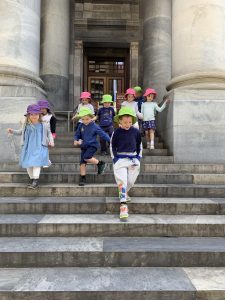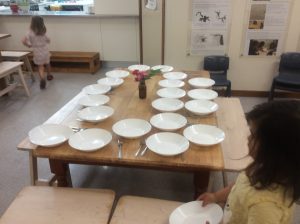How to reuse left over water
Sustainability is an important part of the Early Years Learning Framework and the National Quality Standard. During the first two weeks I observed the children and reflected on meaningful learning experiences, that every child could do and understand. I noticed that at lunch time children did not necessarily finish their glass of water, so I decided to introduce a bucket. I named the bucket, “water for our garden”, to give an opportunity to the children to learn how to collect the water from their glass instead of wasting it, and then to reuse it – as my learning project for sustainability. The aim of this experience was to support the children in learning about implementing sustainable practices, by fostering respect and care for their environment.
I chose water use as I believe it is the most important natural resource on Earth in order to sustain life and keep our environment viable. As the children are active participants they learn to minimise the effects of water shortages in an Australian context.
Children develop positive attitudes and values towards sustainable practices by engaging in the learning experiences. Especially by observing adult role models who outwardly show respect for the environment; consequently, this increases their understanding on how to live interdependently with their environment.
First, I decided to discuss the topic with the children during group time and about why it is important to drink water especially on hot days. Here we discussed different uses for water – like watering plants, washing fruits and vegetables – but also for animals to drink. I then introduced the bucket and showed the bucket called: “water for our garden”, while explaining to the children its purpose through demonstration. I pretended to give water to our baby doll and to our animal puppets and plant – here I invited the children to copy and repeat the experience.
Next, I said they can do exactly the same during lunch time by drinking water as our body needs it to survive. Then after lunch time, we should empty our glass of left over water into the bucket next to the bowl where the children were already using it to scrape their left over food. Children successfully poured their water in the bucket and then when they were finished tidying up we went to the garden to water the plants and the pear tree.


Lifelong education that recognises young children as global citizens with rights to shape and impact upon their communities is recognised at Halifax Street children centre. Sustainability involves making conscious decisions about how one action impacts the environment. Being mindful of our daily choices fosters understanding of the greater impacts of our decisions, such as reusing resources.
Through experiences, children learn and develop relationships with their world. From a sustainability perspective children can make connections between
experiences, concepts, processes and engage in learning relationships with humans, other species and non-living elements. For example vegetable patch offers opportunities to develop relationships with plants and insects.
Thank you Room 2 children, for showing me your interest on nurturing and caring for your environment. I look forward to observing and documenting this as it continues to develop.




